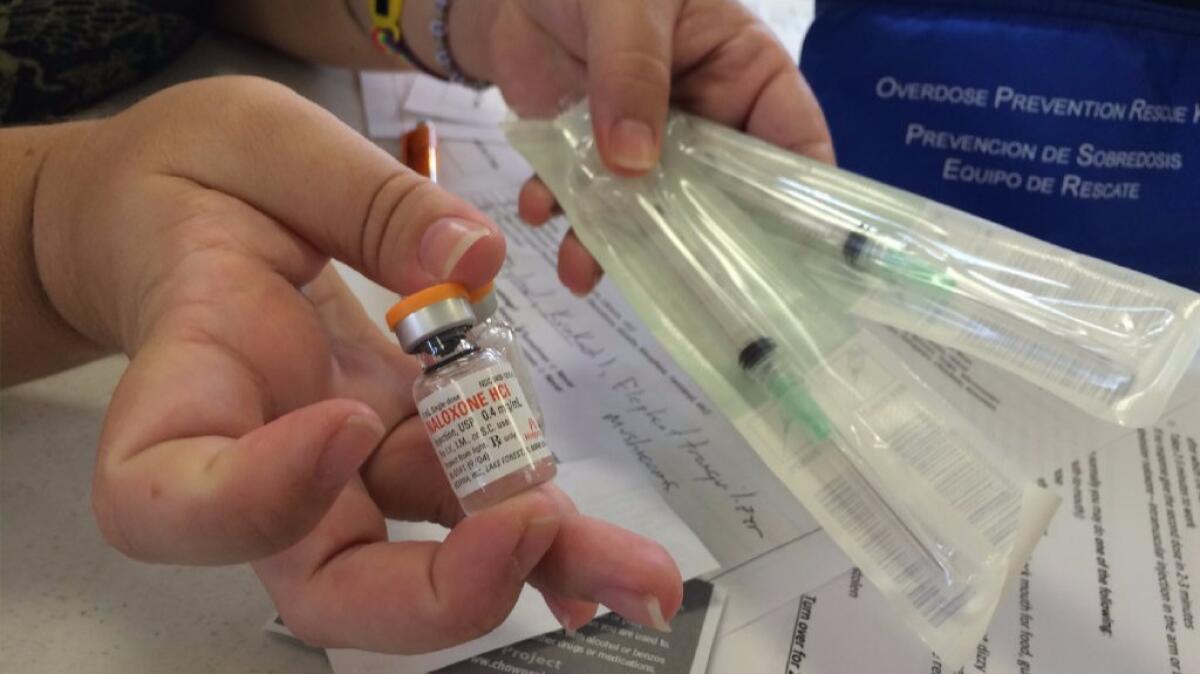FDA asks coders to create an app that matches opioid overdose victims with lifesaving rescue drug

In a bid to stanch the death toll of the nation’s epidemic of opioid drug use, the Food and Drug Administration is calling for the development of a cellphone app that could quickly bring lifesaving medication to the rescue of a person in the throes of a potentially deadly overdose.
The FDA on Monday challenged computer programmers, public health advocates, clinical researchers and entrepreneurs to create an application that can connect opioid users and their friends and loved ones to someone nearby who has a dose of the prescription drug naloxone.
Naloxone quickly reverses the effects of an opioid drug overdose by plugging up the receptors in the brain to which opioid narcotics bind themselves. Now carried by emergency medical crews and available by prescription, naloxone can pull an opioid drug user out of a death spiral in minutes if it is administered quickly enough.
The FDA is deliberating over whether and how it can make naloxone available without a prescription. In the meantime, however, the reversal agent is in too few hands to save all who might benefit.
That’s where a well-designed mobile app might help. If an opioid drug user is found unresponsive with a weak pulse and shallow breathing, the person first on the scene might turn to a naloxone finder on her cellphone to get a dose quickly.
Associate FDA Commissioner Peter Lurie suggested that in a large apartment building, for instance, a first responder might find a neighbor just down the hall who has a dose of naloxone in the medicine chest. “There’s not a minute to waste,” Lurie said, and an app that could speed the arrival of naloxone could save lives.
Lurie acknowledged there probably are legal issues to be worked out, including laws or legal waivers that would absolve a provider of naloxone of liability in the event his or her rescue doesn’t work or prompts an adverse reaction. Those might be modeled on “good Samaritan” laws, adopted by many states, which exempt from liability anyone providing cardiopulmonary resuscitation to someone who appears to have had a heart attack.
More difficult might be the challenge of getting drug users to download an app that speeds the arrival of a reversal drug many are loath to use. Naloxone’s rapid reversal action also brings a drug user’s high to an abrupt end. Even when drug users’ breathing and heartbeat have nearly stopped, they are rarely aware of their peril and rarely grateful for the rescue.
To get app designers going on their submissions, the FDA will host a “code-a-thon” on Oct. 19 and 20. Final submissions are due to the agency by Nov. 7.
The submissions will be assessed for innovation, usability, functionality and adaptability by a panel of judges from the FDA, the National Institute on Drug Abuse and the Substance Abuse and Mental Health Services Administration. The highest-scoring entrant will receive an award of $40,000. And all entrants may apply for Small Business Innovation Research grants from the National Institute of Drug Abuse after the competition is over.
The contest was launched under a 2010 law that allows federal agencies to conduct prize competitions to spur innovation and solve tough problems. This is only the second time the FDA has held a prize competition to help solve a pressing public health need. In the first, the winning entrant developed a means of rapidly identifying salmonella bacteria in fresh produce — a technology FDA field labs across the nation have begun to use.
Follow me on Twitter @LATMelissaHealy and “like” Los Angeles Times Science & Health on Facebook.
MORE IN SCIENCE
Brain cancer overtakes leukemia as deadliest form of childhood cancer, CDC says
10,000 instances of distracted driving a day are due to ‘Pokemon Go’




